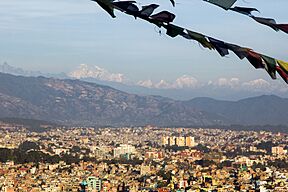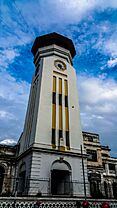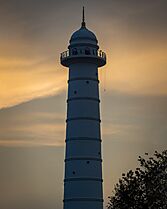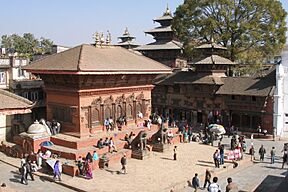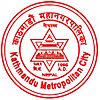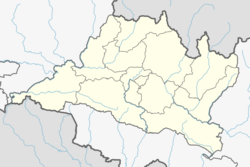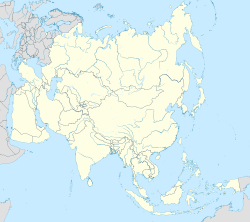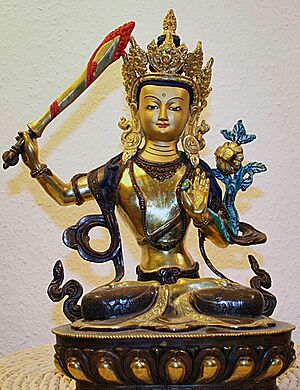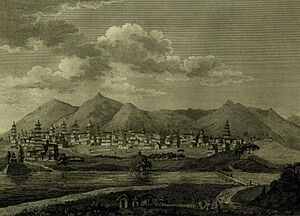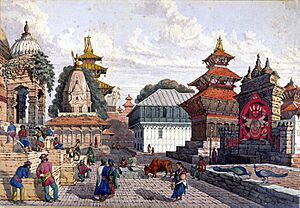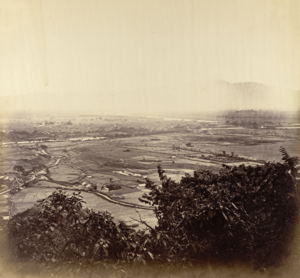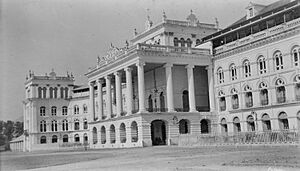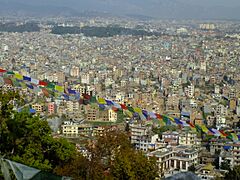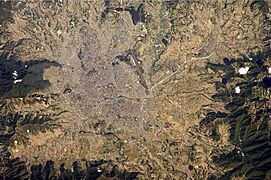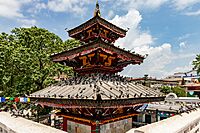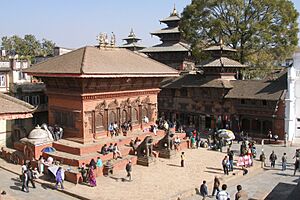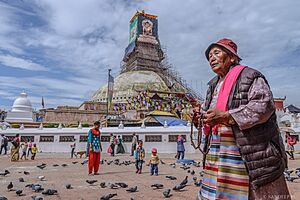Kathmandu facts for kids
Quick facts for kids
Kathmandu
काठमाडौँ
Kasthamandaw, Kantipur, Yen
|
|||
|---|---|---|---|
| Kathmandu Metropolitan City | |||
|
Kathmandu Skyline with Gaurishankar visible
Ghanta Ghar
Kathmandu Durbar Square
|
|||
|
|||
| Nickname(s):
City of Temples
|
|||
| Motto(s): | |||
| Country | |||
| Province | Bagmati | ||
| District | Kathmandu | ||
| Founded by | Manjushri | ||
| Named for | Kasthamandap | ||
| No. of Wards | 32 | ||
| Government | |||
| • Type | Mayor–council government | ||
| • Body | Kathmandu Metropolitan Government | ||
| Area | |||
| • Capital city | 49.45 km2 (19.09 sq mi) | ||
| • Metro | 899 km2 (347 sq mi) | ||
| Elevation | 1,400 m (4,600 ft) | ||
| Population
(2021)
|
|||
| • Capital city | 856,767 | ||
| • Rank | 1st | ||
| • Density | 17,103/km2 (44,300/sq mi) | ||
| • Metro | Approximately 4 million | ||
| • Metro rank | 1st | ||
| Time zone | UTC+05:45 (Nepal Standard Time) | ||
| Postal Code |
44600
|
||
| Area code(s) | 01 | ||
Kathmandu, also known as Kathmandu Metropolitan City, is the capital and largest city of Nepal. It's home to over 845,000 people and about 4 million in its wider urban area. The city is nestled in the Kathmandu Valley, a big valley in the high plains of central Nepal, about 1,400 meters (4,600 feet) above sea level.
Kathmandu is one of the oldest continuously inhabited places in the world, first settled in the 2nd century AD. The valley was historically called the "Nepal Mandala" and was the home of the Newar people, a diverse and cultured group living in the Himalayan foothills. It was once the royal capital of the Kingdom of Nepal and has many palaces, mansions, and gardens built by Nepali nobles. Since 1985, it has been the main office for the South Asian Association for Regional Cooperation (SAARC). Today, it's the center of government for the Federal Democratic Republic of Nepal, which was formed in 2008, and is part of Bagmati Province.
For many years, Kathmandu has been the heart of Nepal's history, art, culture, and economy. It has a mix of different ethnic groups, with most people following Hinduism or Buddhism. Festivals and cultural events are a big part of life here. Tourism is also very important for the city's economy. In 2013, TripAdvisor named Kathmandu one of the top upcoming travel spots in the world. The city is seen as the entry point to the Nepal Himalayas and is home to several World Heritage Sites. These include the Durbar Square, Swayambhu Mahachaitya, Bouddha, and Pashupatinath. The Kathmandu valley is one of the fastest-growing urban areas in South Asia. It is also the largest metropolitan area located in the Himalayas.
Contents
A Look at Kathmandu's Past
Old findings in Kathmandu show signs of ancient civilizations. The oldest discovery is a statue from Maligaon, dating back to 185 AD. Another finding, a brick with ancient writing, is believed to be two thousand years old. Stone carvings found everywhere are key sources for Nepal's history.
The first mention of Kathmandu by a Western traveler was in 1628. A Portuguese traveler named Father Joao Cabral visited the Kathmandu Valley and was welcomed by the king. He reported reaching "Cadmendu," the capital of the Nepal kingdom.
Ancient Stories and Early History
Kathmandu's ancient history is full of traditional myths and legends. One story from the Swayambhu Purana says that Kathmandu was once a huge, deep lake called "Nagdaha," filled with snakes. A wise being named Bodhisattva Manjushri cut a path with his sword, draining the water. He then founded a city called Manjupattan.
Later, a demon named Banasura blocked the water's exit, turning the valley back into a lake. The god Krishna came to Nepal, defeated Banasura, and drained the water again by cutting the Chobhar hill. He brought cowherds with him and made Bhuktaman the king.
Ancient texts also mention a city called Nayapala, famous for its Pashupati Shivalinga. The name Nepal might come from this city.
Very few written records exist from before the medieval Licchavi rulers. According to old royal family records, the Kathmandu Valley was ruled by groups like the Gopalas, Mahispalas, and Kiratas before the Licchavis. The Kirata dynasty was started by Yalambar. During their time, there were two settlements: Yambu in the north and Yengal in the south. Even today, some languages still call Kathmandu "Yambu."
The Licchavi Era
Around 400 AD, the Licchavis from the plains to the south came north and defeated the Kirats, starting the Licchavi dynasty. During this time, Buddhist monks came to Kathmandu. They established the first permanent Buddhist monasteries, which became the basis of Newar Buddhism. This is the only surviving Buddhist tradition in the world that uses Sanskrit.
Eventually, the Licchavi ruler Gunakamadeva combined the two settlements, Koligram and Dakshin Koligram, to create the city of Kathmandu. The city was shaped like Chandrahrasa, Manjushri's sword. It was protected by eight guard posts. Kathmandu became an important stop for trade between India and Tibet, which led to amazing growth in architecture. Famous Chinese traveler Xuanzang described the beautiful palaces of this era. Newar artists were highly respected and traveled across Asia to create religious art. For example, Araniko led a group of artists to Tibet and China. Also, Bhrikuti, a Nepali princess who married a Tibetan king, helped bring Buddhism to Tibet.
The Malla Era
After the Licchavi era came the Malla era. Rulers from another region, fleeing attacks, came to the Kathmandu valley. They married into Nepali royalty, starting this new period. The early Malla years were difficult, with attacks and a huge earthquake that killed many people, including the king. These disasters destroyed much of the older architecture.
Despite these challenges, Kathmandu grew strong again. For most of the Malla era, it controlled trade between India and Tibet. Nepali money even became the standard currency for trade across the Himalayas.
Later in the Malla era, the Kathmandu Valley had four main cities: Kantipur, Lalitpur, Bhaktapur, and Kirtipur. These cities were capitals of the Malla kingdom and competed in art, architecture, and trade. Kings during this time were very involved in building public spaces, temples, and water systems. They also supported arts, laws, and plays. Many beautiful buildings from this time still stand, like Kathmandu Durbar Square, Patan Durbar Square, and Bhaktapur Durbar Square.
Modern History
Early Shah Rule
The Gorkha Kingdom took over the Malla kingdom in 1768. This marked the start of modern Kathmandu. Kathmandu became the capital of the Gorkha empire, and the empire itself was called Nepal. In the early part of this era, Kathmandu kept its unique culture. Buildings with Nepali architecture, like the nine-story tower of Basantapur, were built. However, trade slowed down due to wars. The nine-story tower Dharahara was also built during this time.
Rana Rule
The Rana family began to rule Nepal in 1846. During their time, Kathmandu's focus shifted to being friendly with the British. This led to the construction of the first buildings in a Western European style. Famous examples include Singha Durbar, Garden of Dreams, and the old Narayanhiti palace. The first modern commercial road, the New Road, was also built. The first college (Trichandra College), modern school (Durbar High School), and hospital (Bir Hospital) were built in Kathmandu during this period. Education was mostly for the wealthy.
Kathmandu's Location and Environment
Kathmandu is located in the northwestern part of the Kathmandu Valley, north of the Bagmati River. It covers an area of about 50.7 square kilometers (19.6 square miles). The city is about 1,400 meters (4,600 feet) above sea level. It is surrounded by other towns like Lalitpur (Patan) to the south, Kirtipur to the southwest, and Madyapur Thimi to the east. To the north, the city spreads into areas like Tokha and Budhanilkantha. The urban area of Kathmandu Valley almost covers the entire valley.
Kathmandu has eight rivers flowing through it. The main river is the Bagmati, and its smaller rivers include the Bishnumati and Dhobi Khola. These rivers start in mountains that are 1,500 to 3,000 meters (4,900 to 9,800 feet) high.
The city and valley are in a "Deciduous Monsoon Forest Zone." This means you'll find trees like oak, elm, beech, and maple here. At higher altitudes, there are also coniferous trees.
Kathmandu's Climate
| Weather chart for Kathmandu | |||||||||||||||||||||||||||||||||||||||||||||||
|---|---|---|---|---|---|---|---|---|---|---|---|---|---|---|---|---|---|---|---|---|---|---|---|---|---|---|---|---|---|---|---|---|---|---|---|---|---|---|---|---|---|---|---|---|---|---|---|
| J | F | M | A | M | J | J | A | S | O | N | D | ||||||||||||||||||||||||||||||||||||
|
14
19
2
|
19
21
5
|
34
25
8
|
61
28
12
|
124
29
16
|
236
29
19
|
363
28
20
|
331
29
20
|
200
28
19
|
51
27
13
|
8.3
24
8
|
13
20
4
|
||||||||||||||||||||||||||||||||||||
| temperatures in °C precipitation totals in mm |
|||||||||||||||||||||||||||||||||||||||||||||||
|
Imperial conversion
|
|||||||||||||||||||||||||||||||||||||||||||||||
Kathmandu has a warm, humid climate. The average summer temperature is around 28 to 30 degrees Celsius (82 to 86 degrees Fahrenheit). In winter, the average temperature is about 10.1 degrees Celsius (50.2 degrees Fahrenheit). Sometimes, temperatures can drop to 0 degrees Celsius (32 degrees Fahrenheit) or even lower in winter. Snowfall is rare in the city itself, usually only happening in the surrounding hills.
Most of the rain in Kathmandu comes during the monsoon season, from June to September. The city gets about 1,400 millimeters (55 inches) of rain each year. The air is usually quite humid, around 75%.
Air Quality in Kathmandu
Air pollution is a big problem in the Kathmandu Valley. The air often has small particles (PM2.5) that are much higher than what the World Health Organization recommends. This pollution leads to many health issues. The government and the US Embassy in Kathmandu now share real-time air quality data so people can stay informed.
People of Kathmandu
Kathmandu is a very diverse city, making it the most populated in Nepal. In 2011, Kathmandu city had 975,543 people living in 254,292 homes. The population has been growing quickly.
Languages Spoken in Kathmandu
Nepali (62%) Newari (19%) Tamang (6%) Maithili (3%) Gurung (2%) Magar (2%) Others (6%)
As of 2011, Nepali is the most common language, spoken by 62% of the people. Newari is spoken by 19%. Other languages include Tamang (6%), Maithili (3%), and Gurung (2%). Many people also speak English.
Ethnic Groups in Kathmandu
Ethnic groups in Kathmandu Newar (24.7%) Hill Brahman (24.5%) Chhetri (18%) Tamang (7.8%) Magar (3.8%) Others (21.2%)
The largest group in Kathmandu are the native Newars, making up about 24.7% of the population. Close behind are the Bahuns (Hill Brahmins), who are 24.5% of the population. The Chhetri are the third largest group, at 18%. Other groups include the Tamang (7.8%), Magar (3.8%), and Gurung (2.6%). There are also Nepalese Muslims and people from the Terai region.
Architecture and Cityscape
Kathmandu's location on an ancient trade route between India and Tibet led to a mix of different art and building styles. The city's monuments have been shaped by Hindu and Buddhist traditions over centuries. In 2006, UNESCO declared seven groups of monuments in the Kathmandu valley as a World Heritage Site. These include the Durbar squares of Hanuman Dhoka, Patan, and Bhaktapur. Also included are the Hindu temples of Pashupatinath and Changunarayan, and the Buddhist stupas of Swayambhunath and Boudhanath.
Durbar Squares: Palaces and Temples
"Durbar Square" means "place of palaces." There are three well-preserved Durbar Squares in Kathmandu valley. The one in Kathmandu city is in the old part of town. It has historic buildings from different kingdoms, including the earliest Licchavi dynasty. The area has about 50 temples. The squares were badly damaged in the 2015 earthquake.
Hanuman Dhoka is a group of buildings that includes the royal palace of the Malla and Shah kings. It covers a large area. The oldest part dates back to the mid-1500s. The royal family lived here until 1886.
Kumari Ghar is a palace in the center of Kathmandu, next to Durbar Square. It's where a special royal Kumari, chosen from several young girls, lives.
Kasthamandap is a three-story temple built in the 16th century. It's made in the pagoda style. The name of Kathmandu comes from the word Kasthamandap. It was originally built as a resting place for travelers.
Pashupatinath Temple
The Pashupatinath Temple is a famous 5th-century Hindu temple dedicated to Shiva. It's located on the banks of the Bagmati River and is the oldest Hindu temple in Kathmandu. A large part of the temple was destroyed in the 14th century, so most of what you see today was built in the 19th century. The temple is a UNESCO World Heritage Site. Shivaratri, a festival for Shiva, is the most important event here, drawing thousands of visitors.
Only Hindus are allowed inside the temple. Others can view it from across the Bagmati River. The priests at this temple have been Brahmins from southern India for a long time. This tradition was started to encourage cultural exchange. The temple is built in the pagoda style, with carved wooden supports and two-level roofs made of copper and gold.
Boudhanath Stupa
Boudhanath is one of the holiest Buddhist sites in Nepal, along with Swayambhunath. It's a very popular place for tourists. Located about 11 kilometers (7 miles) from central Kathmandu, its huge mandala makes it one of the largest spherical stupas in Nepal. Boudhanath became a World Heritage Site in 1979.
The base of the stupa has 108 small images of the Buddha. It's surrounded by a brick wall with 147 small areas, each with four or five prayer wheels carved with the mantra, Om mani padme hum. Many Tibetan Buddhist pilgrims visit each year. They walk around the stupa, spin prayer wheels, and pray. Thousands of prayer flags hang from the top of the stupa. Many Tibetan monasteries have been built around Boudhanath because many Tibetan refugees have settled here.
Swayambhu Stupa
Swayambhunath is a Buddhist stupa located on a hill in the northwestern part of the city. It is one of the oldest religious sites in Nepal. Both Buddhists and Hindus consider it sacred. The stupa has a large dome at its base. Above the dome is a square structure with the eyes of Buddha looking in all four directions. There are also carved decorations above each side, and thirteen tiers leading up to a small golden spire at the very top.
Rani Pokhari: The Queen's Pond
Ranipokhari is a historic artificial pond in the heart of Kathmandu. King Pratap Malla built it in 1670 for his queen, who was sad after losing her son. A large stone elephant statue to the south represents King Pratap Malla and his two sons. The Balgopaleshwor Temple stands on an island in the middle of the pond. Rani Pokhari is opened to the public once a year during the Tihar festival. It's one of Kathmandu's most famous landmarks, known for its religious and beautiful setting.
Culture and Arts
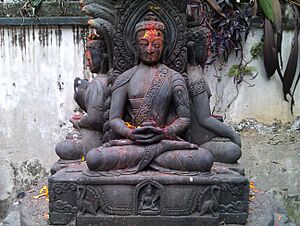
Kathmandu Valley, home to the Newars, is like a huge treasure chest of art and sculptures. These artworks are made from wood, stone, metal, and clay. You can find them everywhere: in temples, shrines, stupas, and palaces. They are also seen on street corners and in private courtyards. Most of the art shows gods and goddesses. Nepal's art became famous worldwide after the country opened up in 1950.
Nepali art often combines Hindu and Buddhist ideas. It includes traditional paintings called Paubhas (or Thangkas in Tibet), which are linked to religious history. There are also modern Western-style paintings, including nature scenes or abstract art.
Museums in Kathmandu
Kathmandu has many museums and art galleries. These include the National Museum of Nepal and the Natural History Museum of Nepal. Nepal's art and architecture mix two ancient religions, Hinduism and Buddhism. This blend is seen in the many temples, shrines, and palaces that are part of the UNESCO World Heritage Site. The museums show unique items and paintings from the 5th century to today.
Some important museums and art galleries are:
- The National Museum
- The Natural History Museum
- Hanuman Dhoka Palace Complex
- The Kaiser Library
- The National Art Gallery
- The NEF-ART (Nepal Fine Art) Gallery
- The Nepal Art Council Gallery
- Narayanhiti Palace Museum
- The Taragaon Museum
The National Museum is in the western part of Kathmandu, near the Swayambhunath stupa. It's the most important museum in the country. It has a large collection of weapons, art, and old items that are historically and culturally important. It was first set up in 1928 to store war trophies and weapons.
The Natural History Museum is at the foot of Swayambhunath hill. It has a big collection of different animals, butterflies, and plants.
The Narayanhiti Palace Museum is in the north-central part of Kathmandu. The name "Narayanhiti" comes from Narayana, a form of the Hindu god Vishnu, and Hiti, meaning "water spout." The current palace building was built in 1970. This palace was where the Nepali royal massacre happened. After the monarchy ended, it was turned into a museum.
The Taragaon Museum shows the modern history of the Kathmandu valley. It aims to record 50 years of research and efforts to protect the cultural heritage of the valley. It shows what artists, photographers, and others from abroad contributed in the second half of the 20th century.
Art Galleries
Kathmandu is a hub for art in Nepal. It displays works by both modern and historical artists. Patan, a nearby ancient city, is especially known for its beautiful arts and crafts. Art in Kathmandu is lively, mixing traditional and modern styles from many different cultures.
Kathmandu has many notable art galleries. The NAFA Gallery is in Sita Bhavan, an old palace. The Srijana Contemporary Art Gallery shows works by modern painters and sculptors. The Moti Azima Gallery has an impressive collection of traditional tools and handmade items from a medieval Newar house. The J Art Gallery displays art by famous Nepali painters. The Nepal Art Council Gallery has art from both national and international artists.
Literature and Libraries
The National Library of Nepal is in Patan. It's the largest library in the country, with over 70,000 books in different languages. It has rare scholarly books from the 17th century. Kathmandu also has the Kaiser Library, which has about 45,000 books from a personal collection. These books cover history, law, art, religion, and philosophy.
The Asa Archives are also important. They focus on the medieval history and religious traditions of the Kathmandu valley. They have a collection of about 6,000 handwritten books and 1,000 palm-leaf manuscripts.
Cinema, Theatre, and Music
Kathmandu is the center of Nepali cinema and theatre. The city has several theatres, including the National Dance Theatre. The Gurukul School of Theatre organizes the Kathmandu International Theater Festival, bringing artists from all over the world.
Kathmandu has many cinemas, both old and new, showing Nepali, Bollywood, and Hollywood films. Some popular ones include QFX Cinemas and Big Movies.
Kathmandu is the heart of music and dance in Nepal. These art forms are key to understanding the city. Musical performances are held in cultural venues. Gunla is a traditional music festival. Newar music started in Kathmandu, but you can find music from all over Nepal here.
In the 1970s, many visitors brought rock music and jazz to Kathmandu. The city is famous for its jazz festival, known as Jazzmandu. It's the only jazz festival in the Himalayan region and started in 2002. It attracts musicians from many countries.
Kathmandu has been mentioned in many songs, including "Katmandu" by Cat Stevens and Bob Seger.
Food in Kathmandu
The main food for most people in Kathmandu is dal bhat. This is rice and lentil soup, usually served with vegetable curries and pickles. Momo, a Nepali version of Tibetan dumplings, is very popular. You can find it everywhere, from street vendors to restaurants. There are many types of momo, including buffalo, chicken, and vegetarian.
Most foods in Kathmandu are non-vegetarian. However, vegetarian options are also common. Eating beef is very rare and considered wrong in many places. Buff (meat from water buffalo) is very common, especially among Newars. Eating pork was once rare but has become more common due to influences from other cultures.
Kathmandu has many restaurants serving Nepali cuisine, Tibetan cuisine, Chinese cuisine, and Indian cuisine. As tourism has grown, new types of food have appeared, like American chop suey. You can also find international fast-food chains like Pizza Hut and KFC.
People in Kathmandu drink more tea than coffee. Tea, called Chiya, is widely served. It's often made with milk, sugar, and spices.
Festivals and Celebrations
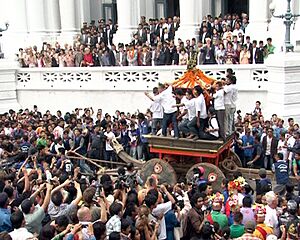
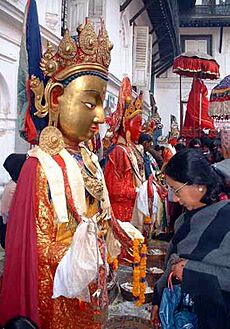
Most of Kathmandu's festivals began during the Malla period or even earlier. Traditionally, the Newar people celebrated these festivals. Now, people from all backgrounds in Kathmandu join in. As the capital, Kathmandu celebrates many national festivals. Different cultures from all over Nepal come together and mix happily in the city.
For centuries, people in Kathmandu have worshipped goddesses and deities. These include the Ajima, Taleju, and Kumari (the living goddess). The artistic buildings are now places of worship. There are 133 festivals celebrated throughout the year.
Some traditional festivals in Kathmandu include Bada Dashain, Tihar, Chhath, Maghe Sankranti, Nag Panchami, and Janai Purnima.
Religions in Kathmandu
Hinduism
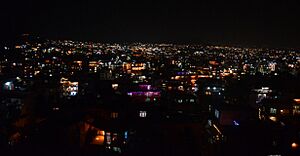
Hinduism is one of the main religions in Kathmandu. It is believed that Hinduism and the caste system were established in the Kathmandu Valley during the Licchavi kingdom (around 400 to 750 AD). The Pashupatinath Temple, Changu Narayan Temple, and the Kasthamandap are very important to Hindus. Other notable Hindu temples include Bajrayogini Temple and Dakshinkali Temple.
The Bagmati River flowing through Kathmandu is considered a holy river by both Hindus and Buddhists. Many Hindu temples are on its banks. Hindus also perform cremations on the banks of this river. It is believed that the Bagmati purifies people spiritually.
Buddhism
Buddhism came to Kathmandu with Buddhist monks during the time of Buddha (around 563–483 BCE). They set up a monastery in Sankhu. During the Hindu Licchavi era, many monasteries were created, leading to the development of Newar Buddhism. This form of Buddhism still uses Sanskrit, an ancient language.
Legendary Princess Bhrikuti (7th century) and artist Araniko (1245–1306 CE) from Kathmandu played a big role in spreading Buddhism in Tibet and China. There are over 108 traditional monasteries in Kathmandu based on Newar Buddhism. Since the 1960s, the number of Tibetan Buddhist monasteries has grown to over fifty.
Other Religions
Sikhism is practiced mainly at the Gurudwara in Kupundole. Jainism is followed by a small community, with a Jain temple in Gyaneshwar.
There are also followers of the Baháʼí Faith in Kathmandu, with a national office in Shantinagar.
Kathmandu has about 170 Christian churches. Christian hospitals, charities, and schools also operate here. Nepali citizens who became Christians while serving in the Indian and British armies have helped spread Christianity and build churches in Nepal.
Education in Kathmandu
Kathmandu is home to Nepal's oldest modern school, the Durbar High School, and its oldest college, the Tri-Chandra College. The largest and oldest university in Nepal, the Tribhuvan University, is located in Kirtipur, near Kathmandu.
The oldest engineering college in Nepal, Thapathali Campus, is also in Kathmandu. The best schools and colleges in Nepal are found in Kathmandu and its nearby cities. Every year, thousands of students from all over Nepal come to Kathmandu to study.
Tourism in Kathmandu
Tourism is a very important industry for Nepal. It began around 1950 when the country became more open to the world. In 1956, air travel started, and the Tribhuvan Highway connected Kathmandu to India. Organizations were created to promote tourism. Nepal also joined international tourist groups. All these efforts helped tourism grow greatly in Nepal, especially in Kathmandu.
Tourism is a major source of income for many people in the city, with hundreds of thousands of visitors each year. Hindu and Buddhist pilgrims from around the world visit Kathmandu's religious sites like Pashupatinath, Swayambhunath, and Boudhanath. After a period of conflict, tourism increased significantly, with over 500,000 tourists in 2009. The beautiful Himalayas and rich cultural heritage are big draws for visitors.
The Thamel area is Kathmandu's main "traveler's hub." It's full of guest houses, restaurants, shops, and bookstores for tourists. Another popular area is Jhamel. Jhochhen Tol, or Freak Street, was popular with hippies in the 1960s and 70s and is still an alternative to Thamel. Ason is a traditional market and ceremonial square on the old trade route to Tibet.
With the growth of tourism, the hotel industry in Kathmandu has improved a lot. The city now has several luxury hotels like the Hyatt Regency, Dwarika's, and Hotel Yak & Yeti. Many of these five-star hotels also have casinos. There are also many four-star and three-star hotels.
Getting Around Kathmandu
Roads
Nepal has a large network of roads, which has helped the country's economy and tourism. In Kathmandu, transportation is mainly by road and air because of the hilly land. Kathmandu is connected by the Tribhuvan Highway to India in the south, the Prithvi Highway to the west, and the Araniko Highway to China in the north. The BP Highway connects Kathmandu to eastern Nepal. A new fast-track road is being built to make travel to the southern plains even shorter.
Sajha Yatayat provides regular bus services throughout Kathmandu and the valley. Other bus companies also operate many routes.
Air Travel
The main international airport for Kathmandu is Tribhuvan International Airport, about 6 kilometers (3.7 miles) from the city center. It has domestic and international terminals. It connects Kathmandu to over 30 cities in Europe, Asia, and the Middle East. Many Nepali airlines also fly from Kathmandu to other major towns across Nepal.
Ropeways
Ropeways are another way to travel in hilly areas. A ropeway used to operate between Kathmandu and Hetauda, carrying goods. It has since stopped working. Currently, a cable car service operates in Kathmandu at Chandragiri Hills, offering scenic views.
Sports in Kathmandu
Cricket and football are the most popular sports among young people in Nepal. Kathmandu has several stadiums. The National Sports Council has its headquarters here. The only international football stadium in the city is the Dasharath Rangasala. It's a multi-purpose stadium used mostly for football matches and cultural events. It's the largest stadium in Nepal, holding 25,000 spectators. The Martyr's Memorial A-Division League is held here every year.
Kathmandu is also home to some of Nepal's oldest cricket clubs. The Kathmandu Kings XI team represents Kathmandu in the Everest Premier League.
Sister Cities
Kathmandu has "sister city" relationships with many cities around the world. This means they share cultural and educational ties.
Proposed Sister Cities
 Bangkok, Thailand
Bangkok, Thailand
Famous People from Kathmandu
- King Tribhuvan
- King Mahendra
- King Birendra
- Bhimsen Thapa, a former Prime Minister of Nepal
- Jung Bahadur Rana, a former Prime Minister of Nepal
- Laxmi Prasad Devkota, a famous writer
- Dharma Bhakta Mathema, a national hero
- Gangalal Shrestha, a national hero
- Manisha Koirala, a Bollywood actress
- Rajesh Hamal, an actor
- Anuradha Koirala, a social activist
- Pushpa Basnet, a social activist
- Paras Khadka, a cricketer
- Balendra Shah, a rapper and current mayor
- Nirmal Purja, a famous mountaineer
Images for kids
-
Dharahara in 2014
-
Alleyway in Boudhanath
See also
 In Spanish: Katmandú para niños
In Spanish: Katmandú para niños


